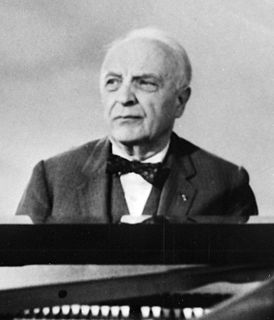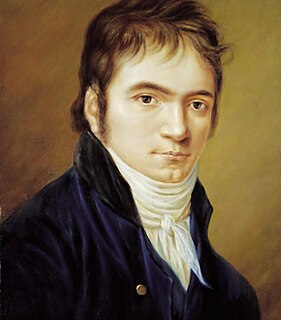Related Research Articles

In music, a cadenza is, generically, an improvised or written-out ornamental passage played or sung by a soloist or soloists, usually in a "free" rhythmic style, and often allowing virtuosic display. During this time the accompaniment will rest, or sustain a note or chord. Thus an improvised cadenza is indicated in written notation by a fermata in all parts. A cadenza will usually occur over the final or penultimate note in a piece, the lead-in or over the final or penultimate note in an important subsection of a piece. It can also be found before a final coda or ritornello.

Ludwig van Beethoven composed his Violin Concerto in D major, Op. 61, in 1806. Its first performance by Franz Clement was unsuccessful and for some decades the work languished in obscurity, until revived in 1844 by the then 12-year-old violinist Joseph Joachim with the orchestra of the London Philharmonic Society conducted by Felix Mendelssohn. Since then it has become one of the best-known violin concertos, considered by Joachim himself to be the "greatest" German violin concerto.
Joan Tower is a Grammy-winning contemporary American composer, concert pianist and conductor. Lauded by The New Yorker as "one of the most successful woman composers of all time", her bold and energetic compositions have been performed in concert halls around the world. After gaining recognition for her first orchestral composition, Sequoia (1981), a tone poem which structurally depicts a giant tree from trunk to needles, she has gone on to compose a variety of instrumental works including Fanfare for the Uncommon Woman, which is something of a response to Aaron Copland's Fanfare for the Common Man, the Island Prelude, five string quartets, and an assortment of other tone poems. Tower was pianist and founding member of the Naumburg Award-winning Da Capo Chamber Players, which commissioned and premiered many of her early works, including her widely performed Petroushskates.

The Piano Concerto No. 5 in E♭ major, Op. 73, known as the Emperor Concerto in English-speaking countries, is a concerto composed by Ludwig van Beethoven for piano and orchestra. Beethoven composed the concerto in 1809 under salary in Vienna, and he dedicated it to Archduke Rudolf, who was his patron, friend, and pupil. Its public premiere was on 28 November 1811 in Leipzig, with Friedrich Schneider as the soloist and Johann Philipp Christian Schulz conducting the Gewandhaus Orchestra. Beethoven, usually the soloist, could not perform due to declining hearing.
The Violin Concerto No. 1 in A minor, Op. 77, was originally composed by Dmitri Shostakovich in 1947–48. He was still working on the piece at the time of the Zhdanov Doctrine, and in the period following the composer's denunciation it could not be performed. In the time between the work's initial completion and the first performance, the composer, sometimes with the collaboration of its dedicatee, David Oistrakh, worked on a number of revisions. The concerto was finally premiered by the Leningrad Philharmonic under Yevgeny Mravinsky on 29 October 1955. It was well received, Oistrakh remarking on the "depth of its artistic content" and describing the violin part as a "pithy 'Shakespearian' role".

Felix Mendelssohn's Violin Concerto in E minor, Op. 64, is his last large orchestral work. It holds an important place in the violin repertoire and is one of the most popular and most frequently performed violin concertos in history. A typical performance lasts just under half an hour.

Alun Hoddinott CBE was a Welsh composer of classical music, one of the first to receive international recognition.

Ferdinand Ries was a German composer. Ries was a friend, pupil and secretary of Ludwig van Beethoven. He composed eight symphonies, a violin concerto, nine piano concertos, three operas, and numerous other works, including 26 string quartets. In 1838 he published a collection of reminiscences of his teacher Beethoven, co-written with Franz Wegeler. The symphonies, some chamber works—most of them with piano—his violin concerto and his piano concertos have been recorded, exhibiting a style which, given his connection to Beethoven, lies between the Classical and early Romantic styles.

Robert Casadesus was a renowned 20th-century French pianist and composer. He was the most prominent member of a distinguished musical family, being the nephew of Henri Casadesus and Marius Casadesus, husband of Gaby Casadesus, and father of Jean Casadesus. The preferred pronunciation of his last name is "Kah-zah-deh-su" with a silent final "s." Per live interview ca. 1970 of Robert Casadesus by announcer Bill Agee of KKHI-AM-FM San Francisco during a live San Francisco Symphony concert, Mr. Casadesus indicated that he pronounced his name as it is pronounced in Spanish, Kah-sah-deh'sus, final s pronounced.
The Cello Concerto in B minor, Op. 104, B. 191, is the last solo concerto by Antonín Dvořák. It was written in 1894 for his friend, the cellist Hanuš Wihan, but was premiered in London on March 19, 1896, by the English cellist Leo Stern.

Ludwig van Beethoven's Concerto for Violin, Cello, and Piano in C major, Op. 56, commonly known as the Triple Concerto, was composed in 1803 and published in 1804 by Breitkopf & Härtel. The choice of the three solo instruments effectively makes this a concerto for piano trio, and it is the only concerto Beethoven ever completed for more than one solo instrument. A typical performance takes approximately thirty-seven minutes.

The Piano Concerto No. 2 in B-flat major, Op. 19, by Ludwig van Beethoven was composed primarily between 1787 and 1789, although it did not attain the form in which it was published until 1795. Beethoven did write a second finale for it in 1798 for performance in Prague, but that is not the finale that was published. It was used by the composer as a vehicle for his own performances as a young virtuoso, initially intended with the Bonn Hofkapelle. It was published in December 1801 as Op. 19, later than the publication in March that year of his later composition the Piano Concerto No. 1 in C major as Op. 15, and thus became designated as his second piano concerto.

Ludwig van Beethoven's Piano Concerto No. 1 in C major, Op. 15, was written in 1795, then revised in 1800. It was possibly first performed by Beethoven at his first public concert in Vienna on 29 March 1795. It was first published in 1801 in Vienna with dedication to his pupil Princess Anna Louise Barbara Odescalchi, known to her friends as "Babette".

Philip Cipriani Hambly Potter was an English musician. He was a composer, pianist, conductor and teacher. After an early career as a performer and composer, he was a teacher in the Royal Academy of Music in London and was its principal from 1832 to 1859.
The Concerto in C minor for Piano, Trumpet, and String Orchestra, Op. 35, was completed by Dmitri Shostakovich in 1933. The concerto was an experiment with a neo-baroque combination of instruments.

Radu Lupu is a Romanian pianist. He is widely recognized as one of the greatest living pianists. Born in Galați, Romania, Lupu began studying piano at the age of six. Two of his major piano teachers were Florica Musicescu, who was also the teacher of Dinu Lipatti, and Heinrich Neuhaus, who was also the teacher of Sviatoslav Richter and Emil Gilels. From 1966 to 1969, he won first prizes of three of the world's most prestigious piano competitions: the Van Cliburn International Piano Competition (1966), the George Enescu International Piano Competition (1967), and the Leeds International Pianoforte Competition (1969). These victories launched Lupu's international career and he has appeared with all of the major orchestras and at all of the major festivals and music capitals of the world.
Olli Mustonen is a Finnish pianist, conductor, and composer.
The Concerto for Orchestra is an orchestral composition by the American composer Joan Tower. The work was jointly commissioned by the St. Louis Symphony, the Chicago Symphony Orchestra, and the New York Philharmonic.
The Piano Concerto No. 1, Op. 28, is the first piano concerto by the Argentinian composer Alberto Ginastera. The work was commissioned by the Koussevitzky Foundation and was completed in 1961. It was first performed by the pianist João Carlos Martins and the National Symphony Orchestra conducted by Howard Mitchell in Washington, D.C., on April 22, 1961. The concerto was Ginastera's first composition for piano since his Piano Sonata No. 1, Op. 22, written in 1952. It is dedicated to the memory of Serge and Natalie Koussevitzky.
The Piano Concerto No. 2, Op. 39, is the second piano concerto by the Argentinian composer Alberto Ginastera. The work was commissioned by the Indianapolis Symphony Orchestra for the pianist Hilde Somer, to whom the concerto is dedicated. It was first performed by Somer and the Indianapolis Symphony Orchestra conducted by Izler Solomon on March 22, 1973.
References
- 1 2 3 Tower, Joan (1985). "Concerto for Piano (Homage to Beethoven)". G. Schirmer Inc. Retrieved July 28, 2020.
- ↑ Holland, Bernard (February 3, 1986). "Music: Tower Concerto". The New York Times . Retrieved July 28, 2020.